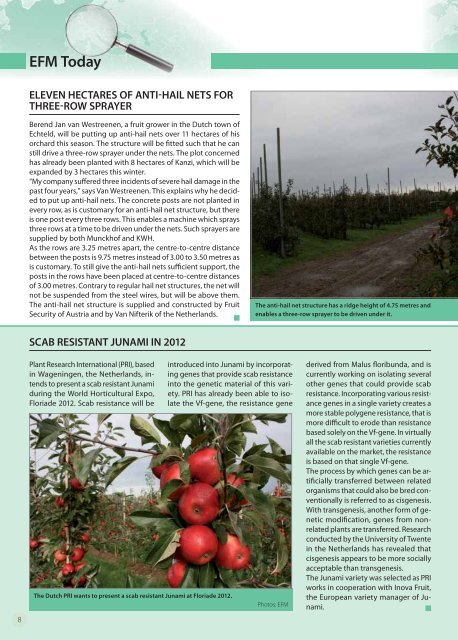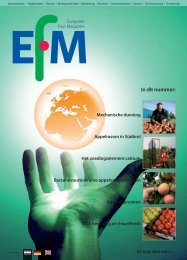In this edition: - The European Fruit Magazine
In this edition: - The European Fruit Magazine
In this edition: - The European Fruit Magazine
Create successful ePaper yourself
Turn your PDF publications into a flip-book with our unique Google optimized e-Paper software.
8<br />
EFM Today<br />
ELEVEN HECTARES OF ANTI-HAIL NETS FOR<br />
THREE-ROW SPRAYER<br />
Berend Jan van Westreenen, a fruit grower in the Dutch town of<br />
Echteld, will be putting up anti-hail nets over 11 hectares of his<br />
orchard <strong>this</strong> season. <strong>The</strong> structure will be fi tted such that he can<br />
still drive a three-row sprayer under the nets. <strong>The</strong> plot concerned<br />
has already been planted with 8 hectares of Kanzi, which will be<br />
expanded by 3 hectares <strong>this</strong> winter.<br />
“My company suff ered three incidents of severe hail damage in the<br />
past four years,” says Van Westreenen. This explains why he decided<br />
to put up anti-hail nets. <strong>The</strong> concrete posts are not planted in<br />
every row, as is customary for an anti-hail net structure, but there<br />
is one post every three rows. This enables a machine which sprays<br />
three rows at a time to be driven under the nets. Such sprayers are<br />
supplied by both Munckhof and KWH.<br />
As the rows are 3.25 metres apart, the centre-to-centre distance<br />
between the posts is 9.75 metres instead of 3.00 to 3.50 metres as<br />
is customary. To still give the anti-hail nets suffi cient support, the<br />
posts in the rows have been placed at centre-to-centre distances<br />
of 3.00 metres. Contrary to regular hail net structures, the net will<br />
not be suspended from the steel wires, but will be above them.<br />
<strong>The</strong> anti-hail net structure is supplied and constructed by <strong>Fruit</strong><br />
Security of Austria and by Van Nifterik of the Netherlands.<br />
SCAB RESISTANT JUNAMI IN 2012<br />
Plant Research <strong>In</strong>ternational (PRI), based<br />
in Wageningen, the Netherlands, intends<br />
to present a scab resistant Junami<br />
during the World Horticultural Expo,<br />
Floriade 2012. Scab resistance will be<br />
introduced into Junami by incorporating<br />
genes that provide scab resistance<br />
into the genetic material of <strong>this</strong> variety.<br />
PRI has already been able to isolate<br />
the Vf-gene, the resistance gene<br />
<strong>The</strong> Dutch PRI wants to present a scab resistant Junami at Floriade 2012.<br />
<strong>The</strong> anti-hail net structure has a ridge height of 4.75 metres and<br />
enables a three-row sprayer to be driven under it.<br />
Photos: EFM<br />
derived from Malus fl oribunda, and is<br />
currently working on isolating several<br />
other genes that could provide scab<br />
resistance. <strong>In</strong>corporating various resistance<br />
genes in a single variety creates a<br />
more stable polygene resistance, that is<br />
more diffi cult to erode than resistance<br />
based solely on the Vf-gene. <strong>In</strong> virtually<br />
all the scab resistant varieties currently<br />
available on the market, the resistance<br />
is based on that single Vf-gene.<br />
<strong>The</strong> process by which genes can be artifi<br />
cially transferred between related<br />
organisms that could also be bred conventionally<br />
is referred to as cisgenesis.<br />
With transgenesis, another form of genetic<br />
modifi cation, genes from nonrelated<br />
plants are transferred. Research<br />
conducted by the University of Twente<br />
in the Netherlands has revealed that<br />
cisgenesis appears to be more socially<br />
acceptable than transgenesis.<br />
<strong>The</strong> Junami variety was selected as PRI<br />
works in cooperation with <strong>In</strong>ova <strong>Fruit</strong>,<br />
the <strong>European</strong> variety manager of Junami.



